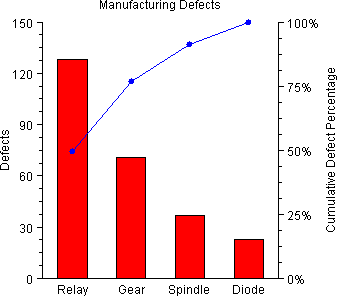Example: Pareto Chart
The number of defects caused by four different factors were measured and plotted as a Pareto Chart. The class ParetoChart
sorts the factors in order of number of defects. This class can be used either as an applet or as an application.
import com.imsl.chart.*;
import com.imsl.chart.qc.ParetoChart;
public class ParetoEx1 extends javax.swing.JApplet {
public void init() {
Chart chart = new Chart(this);
JPanelChart panel = new JPanelChart(chart);
getContentPane().add(panel, java.awt.BorderLayout.CENTER);
setup(chart);
}
static private void setup(Chart chart) {
AxisXY axisBar = new AxisXY(chart);
int numberDefects[] = {71, 23, 128, 37};
String labels[] = {"Gear", "Diode", "Relay", "Spindle"};
ParetoChart pareto = new ParetoChart(axisBar, labels, numberDefects);
pareto.setFillColor(java.awt.Color.red);
pareto.addCumulativeLine();
Data cumulativeLine = pareto.getCumulativeLine();
cumulativeLine.setMarkerType(Data.MARKER_TYPE_FILLED_CIRCLE);
cumulativeLine.setLineColor(java.awt.Color.blue);
cumulativeLine.setMarkerColor(java.awt.Color.blue);
chart.getChartTitle().setTitle("Manufacturing Defects");
axisBar.getAxisY().getAxisTitle().setTitle("Defects");
pareto.getCumulativeAxis().getAxisY().getAxisTitle().
setTitle("Cumulative Defect Percentage");
}
public static void main(String argv[]) {
JFrameChart frame = new JFrameChart();
ParetoEx1.setup(frame.getChart());
frame.setVisible(true);
}
}
Output

Link to Java source.
